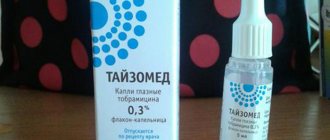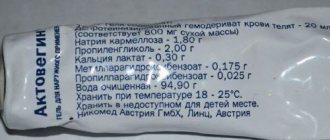CIPROPHARM: instructions, reviews, analogues, price in pharmacies
Cipropharm drops are a broad-spectrum antimicrobial agent of the fluoroquinolone group. It has a bactericidal effect, the mechanism of which is due to the inhibition of bacterial DNA gyrase with disruption of DNA synthesis, cell growth and division.
It has a wide spectrum of antimicrobial action with the greatest activity against gram-negative bacteria and a less pronounced effect on anaerobes. Highly active against most gram-negative bacteria: Pseudomonas aeruginosa, Haemophilus influenzae, Escherichia coli, Shigella spp., Salmonella spp., Neisseria meningitidis, N.
gonorrhoeae. Active against many strains of Staphylococcus spp. (producing or not producing penicillinase, methicillin-resistant), some strains of Enterococcus spp., as well as Campylobacter spp., Legionella spp., Mycoplasma spp., Chlamidia spp., Mycobacterium spp. Ciprofloxacin is active against bacteria that produce beta-lactamases.
Pharmacokinetics
.
When the drug is applied topically, the therapeutic concentration of the active substance is achieved in the tissues and biological fluids of the eye or ear tissue.
Indications for use
Indications for use of the drug Cipropharm are:
– Corneal ulcers and superficial infections of the eye(s) and its appendages caused by strains of bacteria sensitive to ciprofloxacin.
– Acute otitis of the external ear, as well as acute otitis of the middle ear with drainage through a tympanostomy tube, caused by strains of bacteria sensitive to ciprofloxacin.
Mode of application
Application in ophthalmology of Cipropharm :
Use in adults, including elderly patients.
Corneal ulcer:
Cipropharm should be used throughout the day at the following intervals, including at night:
Day 1: instill 2 drops into the affected eye every 15 minutes for the first 6 hours, then 2 drops every 30 minutes for the first 24 hours.
Day 2: instill 2 drops into the affected eye hourly.
From the 3rd to the 14th day, instill 2 drops into the affected eye every 4 hours. If it is necessary to continue treatment for more than 14 days, the dosage regimen is determined by the doctor.
For corneal ulcers, treatment can last more than 14 days; the dosage regimen and duration of treatment are determined by the doctor.
Bacterial superficial infections of the eye and its appendages.
The standard dose is 1-2 drops into the conjunctival sac of each affected eye 4 times a day. For severe infections, the dose may be 1-2 drops every 2 hours in the first 2 days during the daytime.
Treatment usually lasts 7-14 days.
After instillation, tight eyelid closure or nasolacrimal occlusion is recommended.
This reduces the systemic absorption of the drug injected into the eye, which reduces the likelihood of systemic side effects.
In case of concomitant therapy with other local ophthalmic drugs, an interval of 10-15 minutes should be observed between their use.
Children. Dosing is the same as for adults.
For the treatment of bacterial conjunctivitis in children over 1 year of age, Cipropharm is used 1-2 drops 3-4 times a day for 4 days.
To prevent contamination of the tip of the bottle and solution, be careful not to touch the eyelids, surrounding areas, or other surfaces with the tip of the bottle.
Application in otology of Cipropharm drops:
Adults, including older people. The dose is 4 drops of Cipropharm into the ear canal twice a day. For adult patients who require the use of ear tampons, the dose can be doubled only on the first use (i.e. 8 drops).
In general, the duration of treatment should not exceed 5-10 days. In some cases, treatment can be extended, but in this case it is necessary to check the sensitivity of the local microflora.
In the case of concomitant therapy with other local medications, an interval of 10-15 minutes between doses should be observed.
Children. The safety and effectiveness of ciprofloxacin, eye/ear drops 3 mg/ml, when used in otology, has been established only for children over 1 year of age. The dose of Cipropharm is 3 drops into the ear canal twice a day. For children who require the use of ear tampons, the dose can be doubled on the first use only (i.e. 6 drops).
To prevent contamination of the tip of the bottle and solution, be careful not to touch the auricle or ear canal, adjacent areas of the body, or other surfaces with the tip of the bottle.
The external auditory canal must be thoroughly cleaned. To prevent vestibular stimulation, it is recommended that the solution be administered at room temperature or body temperature. The patient should lie on the side opposite the affected ear.
It is advisable to remain in this position for 5-10 minutes.
Also, after local cleansing, a moistened gauze or absorbent cotton swab can be inserted into the ear canal for 1-2 days, but it must be moistened to saturate it with the drug 2 times a day.
Side effects
Visual disturbances: often – a feeling of discomfort, a white coating (observed in patients with a corneal ulcer and with frequent use of the drug.
Plaque appeared, as a rule, from 24 hours to 7 days after the start of treatment and disappeared either immediately or within 13 days after the start of therapy), foreign body sensation, formation of scales/crystals, conjunctival hyperemia and itching; in isolated cases - corneal staining, keratopathy/keratitis, allergic reactions, eyelid swelling, lacrimation, photophobia, corneal infiltration and decreased visual acuity.
Hearing disorders: often – itching in the ear; in isolated cases - ringing in the ear.
Skin disorder: dermatitis.
Others: unpleasant taste in the mouth, nausea, headache.
Contraindications
Contraindications to the use of Cipropharm are: hypersensitivity to quinolones or to the auxiliary ingredients of the solution; viral and fungal diseases of the eye(s).
Pregnancy
:
Since no controlled studies have been conducted in pregnant women, Cipropharm should be used during pregnancy only when the expected benefit to the mother outweighs the potential risk to the fetus.
There is no information about whether ciprofloxacin passes into breast milk after topical use. Therefore, caution should be exercised when prescribing Cipropharma to mothers who are breastfeeding.
Interaction with other drugs
There is evidence that the simultaneous use of certain systemic quinolines leads to an increase in the concentration of theophylline in the blood plasma, affects the metabolism of caffeine and enhances the effect of oral anticoagulants such as warfarin and its derivatives.
Serum creatinine levels were transiently increased in patients taking cyclosporine with systemic ciprofloxacin.
Cipropharm is incompatible with alkaline solutions (bases).
Overdose
In case of overdose of the drug Cipropharm when applied topically to the eye, the excess drug should be washed out of the eye(s) with warm water.
In case of an overdose of the drug when applied topically to the ear, the patient should lie down, turn on his side and wait until the excess fluid drains from the ear.
Storage conditions
Shelf life after opening the bottle is 28 days. Do not use the drug after the expiration date indicated on the package. Store in a place protected from light at a temperature of 8°C to 25°C. Keep out of the reach of children. Do not freeze.
Release form:
Cipropharm – drops.
5 or 10 ml in a bottle. 1 bottle included in a pack.
Compound
1 ml of the drug Cipropharm contains ciprofloxacin hydrochloride 3 mg in terms of ciprofloxacin.
Excipients: benzalkonium chloride; sodium dihydrogen phosphate, dihydrate; sorbitol (E 420); water for injections.
Additionally
You should stop using Cipropharm at the first signs of a skin rash or other signs of a hypersensitivity reaction.
Serious and sometimes fatal cases of hypersensitivity reactions (anaphylactic reactions) have been reported in patients using systemic quinolones, some patients after the first dose.
Some reactions were accompanied by cardiovascular collapse, loss of consciousness, tingling, swelling of the throat or face, dyspnea, urticaria and itching.
Severe anaphylactic reactions require immediate treatment with epinephrine and other resuscitation measures, including oxygen therapy, intravenous fluids, intravenous antihistamines, corticosteroids, vasoconstrictor amines, and mechanical ventilation as clinically indicated.
Moderate to severe phototoxicity has been observed in the form of severe sunburn in patients who were exposed to direct sunlight during systemic use of quinolone class drugs. Excessive exposure to solar radiation should be avoided. If phototoxicity occurs, treatment should be stopped.
Long-term use of ciprofloxacin, like any other antibacterial drugs, can lead to increased growth of microorganisms that are insensitive to it, including fungi.
If superinfection occurs, appropriate treatment should be carried out.
Cipropharm eye/ear drops contain benzalkonium chloride as a preservative, which may cause irritation. It is also known that this preservative can discolor soft contact lenses, therefore, before using Cipropharm, patients should remove contact lenses and wait 15 minutes after instillation of Cipropharm before putting contact lenses back on.
As a general rule, it is not advisable to use contact lenses if you have an eye infection.
When using the drug Cipropharm for the treatment of otitis, it is recommended to conduct a medical examination of patients to timely determine the need for other therapeutic measures (systemic use of antibiotics, surgical treatment).
The ability to influence the reaction rate when driving a vehicle or working with other mechanisms
As with other eye drops, temporary blurred vision or other vision disturbances may affect the ability to drive or operate machinery. If blurred vision occurs, the patient must wait until vision is restored before driving or operating machinery.
After using the drug Cipropharm in the ear, no effects were reported that would affect the ability to drive vehicles or operate other machinery.
Source: https://www.medcentre.com.ua/medicamenty/tsip.html
Adverse reactions
There may be some side effects when using the drops. These symptoms generally include eye discomfort or itching. Less commonly it may occur:
- photophobia;
- allergy;
- swelling;
- keratopathy;
- decreased visual acuity;
- increased lacrimation.
If you drop more than one drop into your eyes, you should immediately wash them with clean water to prevent negative consequences.
Can Cipropharm be dropped into the nose?
The drug Ciprofarm is prescribed for the treatment of diseases of the eyes and ears. It belongs to the group of antibiotics. Suitable for both adults and children. Our review introduces this drug, its action and effectiveness, methods of use and reviews from patients and doctors.
Composition and action
The active component of the product is ciprofloxacin hydrochloride. 1 ml of medicine contains 3 mg of active substance. The drops contain additional components - benzalkonium chloride, sorbitol, water for injection, sodium dihydrogen phosphate.
The medicine fights such types of microbes as:
- staphylococci;
- enterococci;
- campylobacter;
- mycoplasma;
- chlamydia;
- mycobacteria;
- coli;
- salmonella;
- hemophilus influenzae;
- Pseudomonas aeruginosa, etc.
Cipropharm is highly effective in fighting bacteria. The active substance penetrates their shell and destroys DNA. The vital activity of bacteria becomes impossible.
Manufacturers, release forms, prices
The drug Cipropharm is produced by a Ukrainian pharmacological company in the city of Kyiv. It is produced in the form of drops, which are a transparent yellow-green solution. Bottle volume - 10 ml. The proportion of active substance is 0.3%.
Store the drug in a dark place, out of reach of children, for no more than 3 years from the date of manufacture. Once opened, the drops are good for 28 days. After this period, their use is prohibited.
The medicine is sold in a pharmacy with a doctor's prescription. You can buy it for an average of 210 rubles.
Dosage and administration
The dosage of the drug depends on the disease and age of the patient. Before starting treatment, be sure to read the instructions for use.
Eye diseases. Adults
- For infectious inflammation of the eyes and eyelids, instill 1-2 drops 4 times a day.
Severe forms of the disease require more frequent use - every 2 hours. The average course of therapy is 5 days. If necessary, treatment can be continued. But it should not exceed 10 days. After instillation, it is recommended to close your eyes for 10-15 minutes. - For corneal ulcers, the following scheme is followed:
- on the first day, drip 1 drop every 15 minutes for 6 hours, then 1 drop every 30 minutes for the rest of the day, with the exception of sleep time;
- on the second day - 1 drop every hour, except during sleep;
- All subsequent days, instill 1 drop at an interval of 4 hours.
Contraindications
Only a doctor can prescribe the use of an antibiotic for certain indications and after undergoing tests. These eye and ear drops are not effective against fungal and viral pathogens. Self-administration if incorrectly diagnosed can aggravate the disease and delay the recovery process. The main contraindications are:
- child's age up to 1 year;
- During pregnancy and breastfeeding;
- allergy to the components of the drug.











